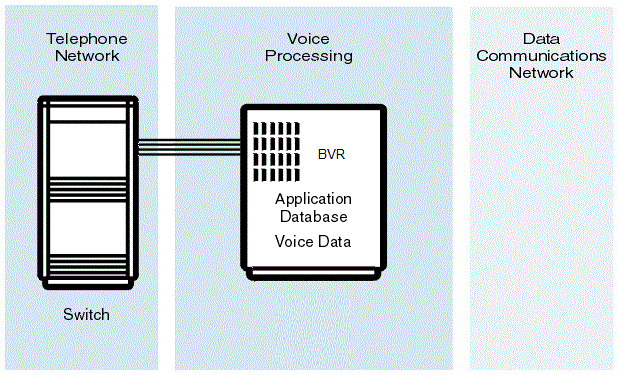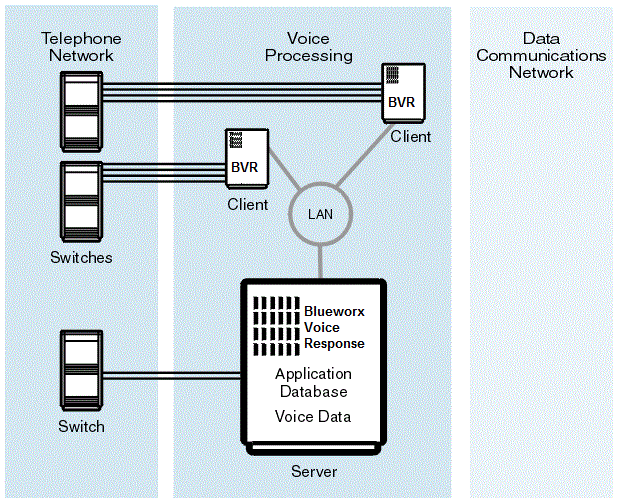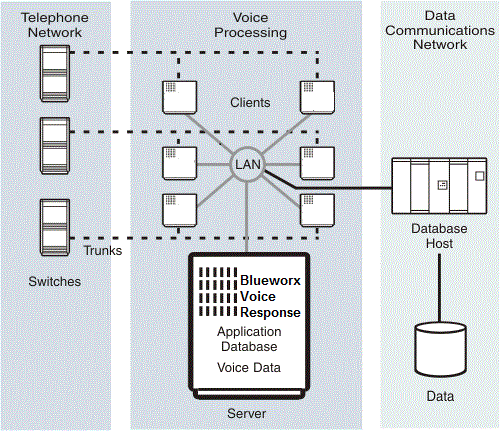You can use a local area network to connect a cluster of Blueworx Voice Response systems. All the systems can then share all the application data in the cluster (such as state tables and custom servers) and all the voice data (such as voice segments and voice messages). When the systems are connected in this way, you can install a voice application on one system in the cluster, and make it available to all the systems. This means that as your business grows, you can add more systems with little additional work.The cluster of Blueworx Voice Response systems is known as a single system image (SSI). This section tells you what you should consider when you plan to create a single system image.
Each system in the cluster is known as a node. Each node is configured either as a client or as a server:
- Client node
- A client node handles the interactions with callers. It runs Blueworx Voice Response (configured as a client), and it must have a connection to your telephony environment. A client node contains no application data; it gets this from the server, to which it is connected by a local area network.
- Database server node
- The database server node contains the application object database. This is a DB2 database that contains all the state tables and prompts that all the Blueworx Voice Response systems in the single system image can use. It also contains information about the custom servers that are installed. The server node has Blueworx Voice Response installed, configured as a server. If you want the server node to handle interactions with some callers, you can add a connection to your telephony environment.
- Voice server node
- A voice server node contains the voice data for all the voice applications that run on the single system image. It also contains the program files for the custom servers that are installed on the single system image. The node stores its information in an AIX file system. This node need not have Blueworx Voice Response installed, unless you want it to handle interactions with some callers; in this event, the node must also have a connection to your telephony environment.
The database server and the voice server are usually in the same Power System, but you can install them onto two separate systems if you are creating a large single system image and you want to distribute the processing load. Note that under the terms of the license for DB2 when supplied with Blueworx Voice Response, DB2 must be installed on the same physical machine as the Blueworx Voice Response software, and must not be used with any other applications.
The nodes of a single system image must be connected using a local area network. The type of network you use depends on the size of the voice solution you are implementing. For example, a small cluster running a simple voice application (such as an information-announcement application that plays recorded weather information) might require only a token ring network. However a larger cluster, used for many voice applications or for a voice messaging service, may require a network that can provide a higher capacity and performance, such as an asynchronous transfer mode (ATM) network.
In comparison, a stand-alone Blueworx Voice Response system (that is, one not configured as an SSI node) must have Blueworx Voice Response, the telephony connection, the application data, and the voice data all installed on the same Power System. If you want to create an additional system, you must install all these items on a new stand-alone system. Figure 1 shows a stand-alone Blueworx Voice Response system, which is not connected to any other Blueworx Voice Response systems. Both the application and voice data it uses are also stored on the same Power System.

Figure 2 shows a small single system image. Each Blueworx Voice Response client has four trunks of telephony, and the server has two trunks installed. However, you do not have to install telephony components onto the server. The single system image shown in the figure is suitable for running an IVR application.

Figure 3 shows a larger single system image. This configuration has more clients installed and there are no telephony components on the server. This configuration is suitable for a large voice messaging system, and it is likely that the server will perform no functions other than to serve the Blueworx Voice Response single system image.
